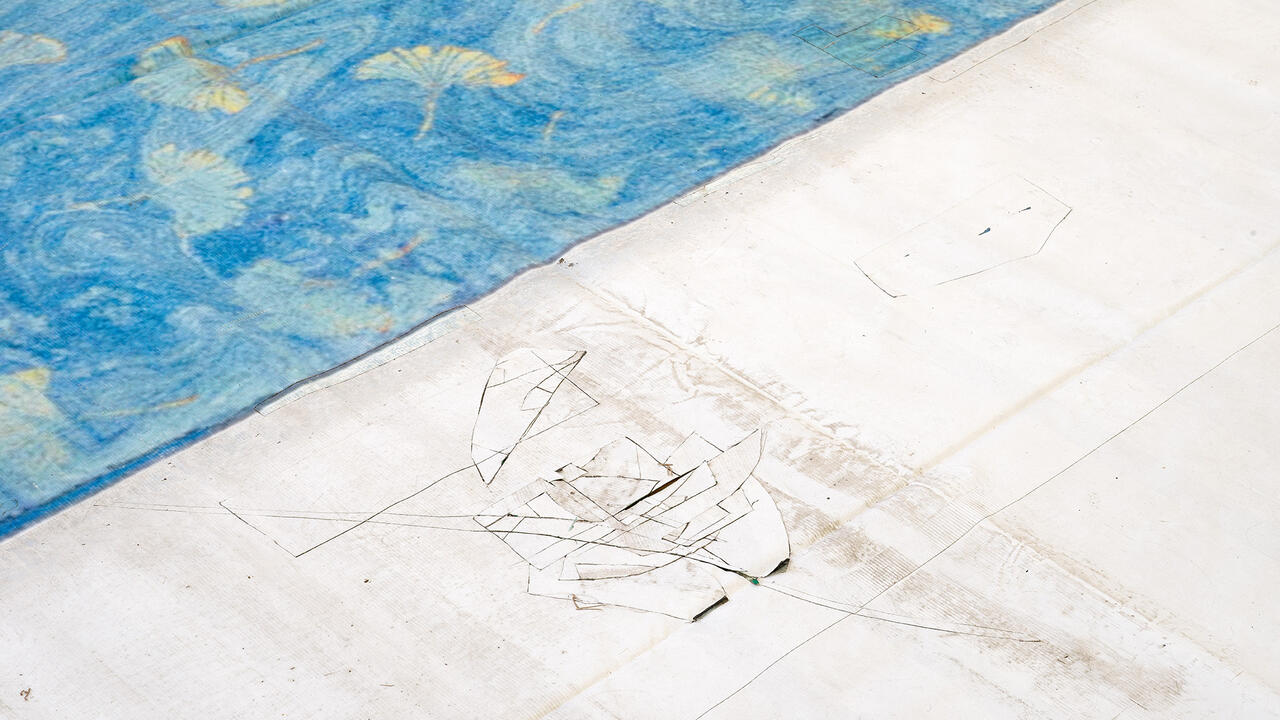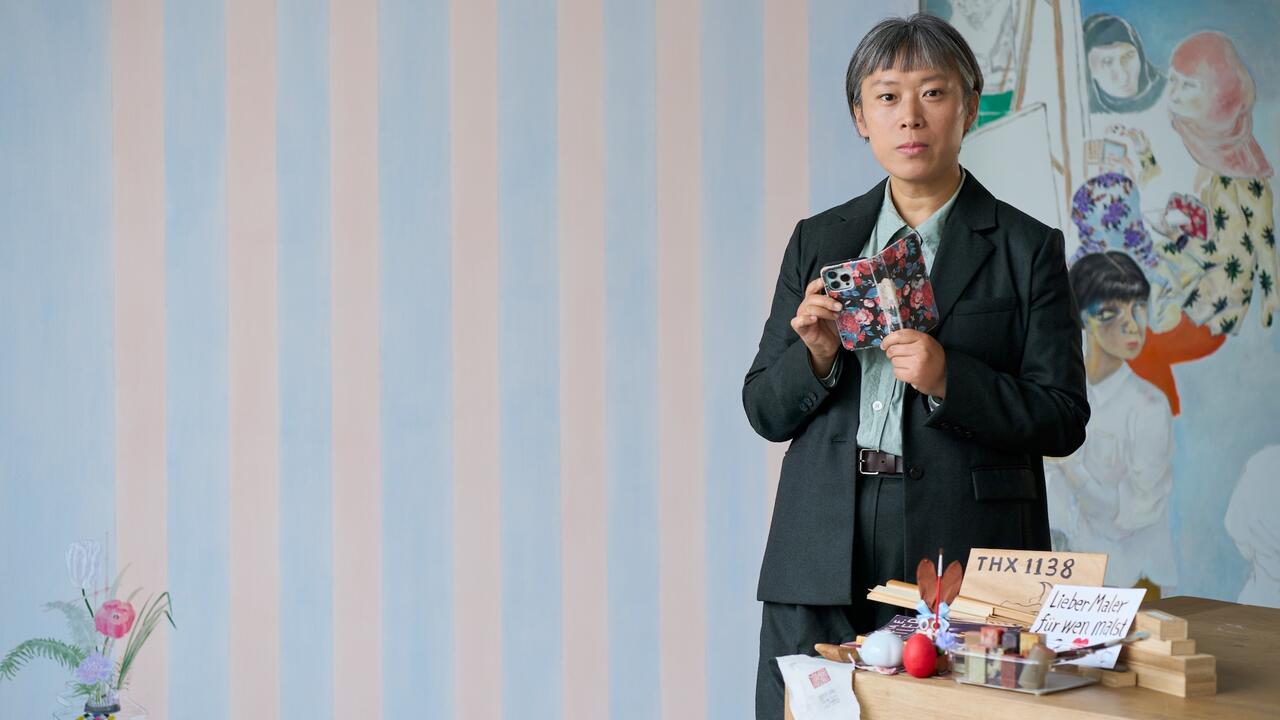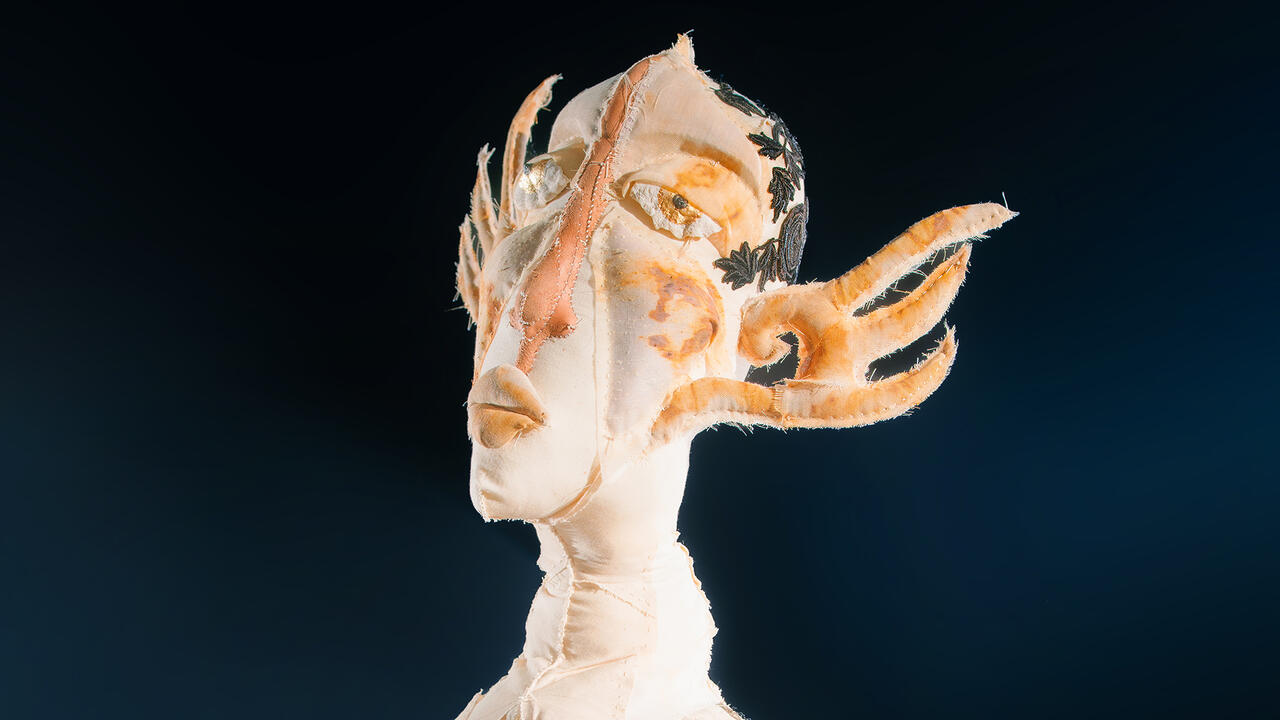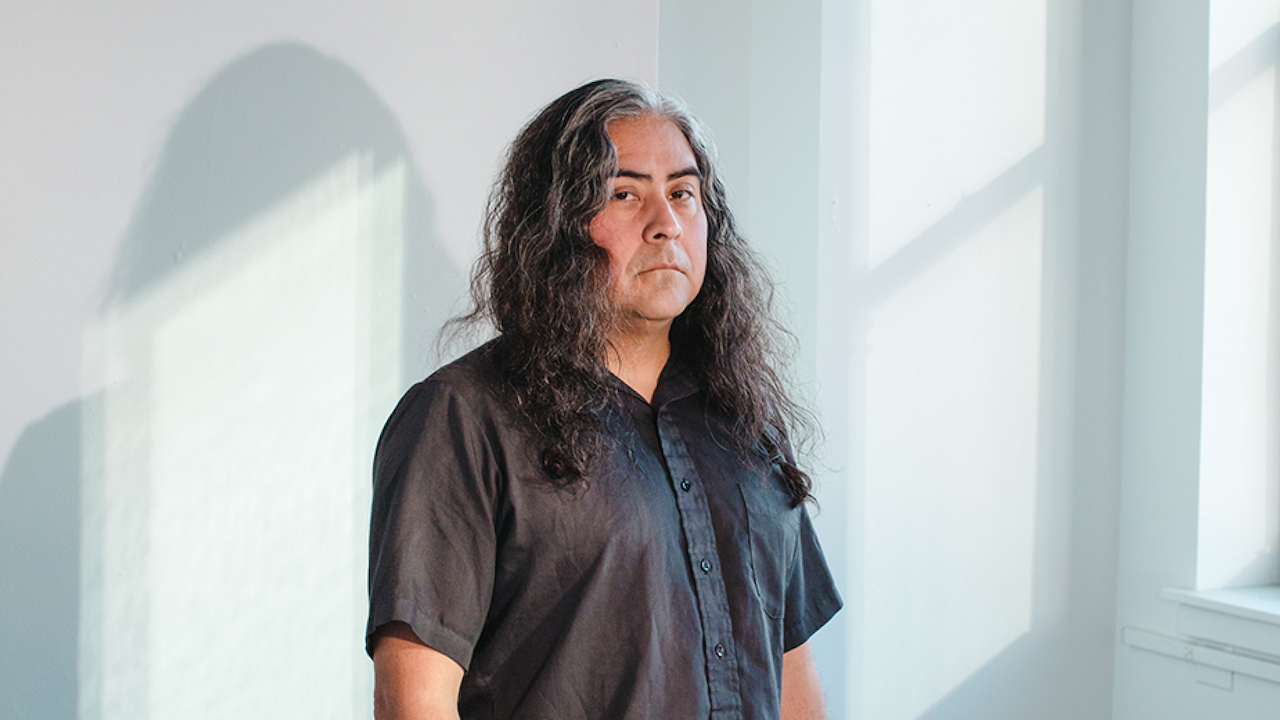After the End
With mordant humour, the art of Michael E. Smith plots the bleak landscapes of exurban America
With mordant humour, the art of Michael E. Smith plots the bleak landscapes of exurban America

At the start of Michael E. Smith’s recent monograph, published in 2013 to accompany his exhibition at the Ludwig Forum in Aachen, there is a black page with two qr codes printed in white. Underneath each are the capitalized inscriptions: ‘BEETLEJUICE’ and ‘FOR HEADS’. This is the artist’s preface to the book.
Scanning the codes with a smartphone leads you to two video links. In FOR HEADS (2013), we are looking through the windscreen of a car on a grey winter’s day as it moves down wide streets, on the edge of a town somewhere. We pass signs for Express Auto Repair, Lotto and Liquor, Kentucky Fried Chicken and Taco Bell. Snow flurries. The windows in many buildings are knocked out or boarded up. The cars have Michigan plates and a road sign points north to Flint, on the Interstate 75. Petrol here is US$2.98 a gallon. Our vehicle is following a white hearse with the word ‘PEACE’ written in its window and, on the radio, the R&B singer Maxwell sings his 1999 hit, ‘Fortunate’.
BEETLEJUICE (2013) is altogether different. It is a close up of three battered old yellow Motorola phones – the kind that can also be used as two-way radios, and that are typically sold off-contract, pre-paid. Burner phones. Over their surfaces scrabble large black beetles, and the phones jostle as if riding on a seething mass of insect life.

These two videos may be the closest that the reticent Smith is likely to come to an expository essay on his work. Between them, they plot points around the US artist’s aesthetic and thematic compass: the bleak landscapes of exurban America, specifically post-recessional Detroit; the tradition of black music; mordant humour; apocalyptic environmentalism; junk technology; cars; depression (in all its senses); horror.
By and large, Smith deals in objects and spaces rather than in representational images. While he has made a small number of videos and photographic works, even his paintings are typically two-sided, existing as objects to be sited – precisely and unexpectedly – within a given architectural environment. In his exhibition at the Ludwig Forum, the artist hung an untitled painting, made of T-shirt fabric encrusted with downy feathers, immediately beneath the counter of the museum shop, where it brushed against unsuspecting visitors’ legs as they paid for their tickets. The small panel looks as if it were the scene of the recent murder of a delicate and vibrantly coloured bird.
Smith has become recognized for his ability to sharpen the atmospheric pitch of a space with the introduction of a few ultra-meagre sculptures, often seemingly made from things he found by the roadside. In his exhibition at the 2014 Triennale di Milano, the building’s large bright hall at first appeared to be empty. Smith’s artworks, such as a length of old garden hose at the foot of a wall, or a bunched-up pair of sweatpants soaked in resin then sawed in two (both Untitled, 2014), were no more dominant than the gallery’s fire-safety equipment and the lighting tracks on the ceiling. Other sculptures offset drabness with revulsion: Untitled (2014), from the same exhibition, consists of a length of steel pipe with a white-feathered cockatiel pelt jammed, headfirst, into one end. It is hard to relax in any room with an object like that leaning in the corner.

Smith troubles the stillness of his sculptures by charging them with the latent energy of something recently alive. He is drawn to a certain kind of weathered surface, a surface that looks corporeal even if it is vegetal or man-made. A dried gourd resembles psoriatic skin; dirty plastic looks like bone; a milky plastic resin recalls saliva, pus or semen. Ontologically, not all of these bodily substances are ‘living’ in the same sense. Skin is alive (it grows, heals itself, is sensitive) but what about tooth or bone? At what point do excreta no longer belong to their host? Saliva and blood and hair and feathers all occupy an animistic grey area, and are indicative of the ways that we, as bodies, are subjects and objects, nature and culture, amalgams of the food we eat, the chemicals we ingest and millions of bacteria. In Smith’s hyper-sensitized world, the lines between animal, vegetable and mineral are kicked over.
Along with industrial materials, clothing and animal parts, food crops up a lot in Smith’s art. It is usually inedible, like the dry oatmeal glued onto the plastic handles of two weed trimmers, in an untitled pair of wall-mounted sculptures from 2012. A favoured technique of the artist is to fill, or half-fill, a plastic milk or soda bottle with coloured resin or urethane foam, sometimes with feathers or fabric entombed within like flies in amber. Smith cuts off the bottle and grinds away part of the resulting stump. At the Ludwig Forum, he shrouded the gallery in a brownish fug by placing film printed with a pattern of writhing tinned spaghetti over a row of high windows. This is food for after the end: wheat and tomatoes processed to within an inch of their lives and preserved for eternity. It looks like minced meat or matted fur.
The politics of food, though diverse, touch on many of the wider preoccupations in Smith’s work. The us promises of choice, safety and freedom are heinously reneged in the case of the country’s corporatized food culture. Patently unhealthy mass-produced foods are marketed specifically to the young and the poor, with a callous disregard for environmental and social consequences. Smith’s art often seems to stand as grim testament to the indifference of the world in which he grew up.
Smith left Detroit in 2012, but the atmospherics and mythology of the city in which he was born continue to hum, indelibly, in the background of his work. Though the media has begun to report cautiously on the bankrupt city’s early renaissance, its ravaged infrastructure still tells its own story of abandonment.1 The normal organizational dynamics of a metropolis no longer apply to this, a city that has emptied itself out from within. Wilderness is interleaved with zones of human habitation; deer, pheasants and falcons thrive in overgrown empty lots. Not that Smith has ever subscribed to a moral polarity between the natural (good) and the man-made (evil). As a child, he would spend summers on his grandparents’ catfish farm in Mississippi; he describes the nature he encountered there – huge bugs, blood-red mud and a poisonous snake that his grandmother hacked to pieces on the living room carpet – as ‘ferocious’.2

As with the American South, the saga of Detroit is also a story about race. When the Big Three automotive companies took their business elsewhere in the 1950s, the predominantly white middle class followed them or moved to the suburbs. The working-class population – predominantly black – stayed. Today, 83 percent of Detroit is African American. Smith, who is white, understands black music, historically, to be synonymous with suffering. Gospel, he told me, is ‘a musical kind of crying’ and ‘all art is some variation on the blues’. He is influenced by the improvisation techniques of jazz and hip-hop, which have much in common with the economy of means evident in black assemblage art, especially that of the 1960s and ’70s. When he stretches the torso of an infant’s romper suit around a huge shovel, in the sculpture Untitled (2014), one cannot help but recall the devastating simplicity of David Hammons’s Bird (1973), a saxophone with a metal spade head pushed into its stem. In another work by Smith, a spiked metal lightening rod connects with a frying pan to conjure a rudimentary stick figure.
Hammons is an artist who believes in the possession of objects by human spirits. Cut hair, bottles that have touched drinkers’ lips, imprints of skin on paper: for him, indexicality is a means of bewitchment.3 Other black assemblage artists, such as John Outterbridge and Noah Purifoy, both influences on Hammons, held to similar principles. Purifoy salvaged charred artefacts from the debris of the Los Angeles Watts Riots and used them, relatively unaltered, in his earliest sculptures from the mid-1960s. Like Smith’s work, assemblage by African Americans from this period is both searing social documentary and metaphysical poetry.
In his 2014 exhibition at The Power Station, Dallas, Smith placed six flat-screen monitors against a window in the industrial space’s high ceiling. Visitors standing on the ground two storeys below could look up and watch a video clip, shot downwards from a helicopter hovering above the sea, that showed an orange stretcher being winched up out of the blue. The found footage was of a rescue mission in the wake of Hurricane Sandy, a detail that was neither available to the viewer nor essential to the piece. Beyond the affective power of this mesmerizing image, it was apparent that here was an item of documentary significance: ‘This has happened,’ it told us.

Sometimes, the outside world forces its way in uninvited. For his exhibition at the Ludwig Forum, Smith included a low-mounted television showing the Cartoon Network, live. (Animation is a fitting corollary to his work, if one considers how perturbing the reality of a walking and talking sponge or gumball or orange, would be.) Cable television was installed in the gallery especially for the exhibition. During the opening, on 15 April, the cheery transmission was interrupted by flash news reports showing the carnage caused by the two bombs that exploded during the Boston Marathon.
Unlike Hammons, Smith is not superstitious, and when coincidences occur in his work he puts it down to the inherent natures of things – of objects, substances or situations – rising to the surface. The sculpture Mike (2013), a matted ball of rooster feathers glued to a mannequin’s cranium, shares its name both with the artist and two of his dealers (Clifton and Benevento) but is actually named after Mike the Headless Chicken, a freakish circus sideshow from the 1940s. Smith simply lays the coincidence at our feet, and leaves us to make of it what we will. Despite the macabre quality of some of his materials, such as human skull or fossilized whale ear bone, he does not believe in spiritual possession.
Smith is a rationalist, but his rationalism also leads him to speculate that the objects to which he is drawn must have accumulated something – not a soul but maybe just soul – along their journeys through the world. They are absorbent, he says, like the carbon filter in a fish tank. W.G. Sebald once wrote: ‘Things outlast us, they know more about us than we know about them: they carry the experience they have had with us inside them and are – in fact – the book of our history opened before us.’4
1 For instance, Ben Austen, ‘The Post-Post-Apocalyptic Detroit’, The New York Times, 11 July 2014
2 All Michael E. Smith quotations from conversations with the author, May – September 2014
3 David Hammons, on hair: ‘You’ve got tons of people’s spirits when you handle that stuff. The same with the wine bottles. A black person’s lips have touched each one of those bottles, so you have to be very, very careful.’ Quoted in Kellie Jones, ‘David Hammons’, Real Life Magazine, 16, 1986, p. 8
4 W.G. Sebald, ‘As Day and Night, Chalk and Cheese: On the Pictures of Jan Peter Tripp’, in Unrecounted: 33 Poems by W.G. Sebald, 33 Lithographs by Jan Peter Tripp, New Directions, New York, p. 83
Michael E. Smith is an artist living in Hopkington, USA. In 2014, his solo exhibitions included The Power Station, Dallas, USA; Susanne Hilberry Gallery, Ferndale, Michigan, USA; Zabludowicz Collection, London, UK; La Triennale di Milano, Italy; and Lulu, Mexico City (opening December). In 2015, Smith will have solo exhibitions at: Establissment d'en face, Brussels, Belgium; Sculpture Center, New York, USA; De Appel, Amsterdam, the Netherlands; and Kunstverein Hannover, Germany.























